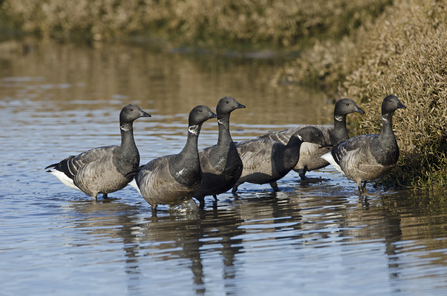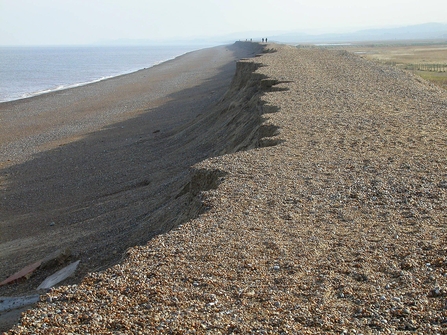The North Norfolk coast has been a popular holiday destination since folk first packed a case and headed off for a summer break. Although many people enjoy the seaside amusements of Hunstanton, there are few that leave without also admiring the beautiful beaches, pretty villages and historic buildings that sit close-by. Come November, when the beating sun has lowered its tempo and the crowds have long dispersed, our coast finds the arrival of new visitors; geese, ducks, and a host of wading birds from the far-off frozen Tundra. They stream down to us during the autumn in their hundreds of thousands, and settle for the winter on our vast mudflats and winding saltmarsh creeks.

Brent geese (credit: David Tipling/2020VISION)
The tidal mudflats of North Norfolk, and particularly the internationally important Wash, are crucial for these vast flocks of birds, and although it may look like lifeless sticky ooze, it teems with muddy marine life. In fact, the invertebrates living in a cubic foot of estuarine mud contain more calorific energy then a Mars bar! Knot and dunlin are constantly on the move, searching for this rich food source exposed by a retreating tide. They are often joined by curlew, grey plover and bar-tailed godwit, each sporting a particular shaped beak, evolved for prising out the specific creatures on which they feed. Skeins of Brent geese descend on the banks of eel grass and hurriedly graze before the tide forces them off again. An occasional pair of shelduck are scattered among them, sifting their crimson bills through the silt, relentlessly searching for tiny snails. Although the days are short, the birds of the mudflats are not governed by the rising and setting of the sun, but by the turning of the tide, and they look for food almost continuously when the sea allows.
The quantity of birds can be an impressive sight, even more so when the incoming tide pushes the flocks closer together and nearer the shore. Then, almost as one, they take flight and head to a favoured roost site. This wondrous spectacle, of so many birds in harmonious flight, suddenly becomes a dramatic life or death struggle as a peregrine falcon strikes. The huge flocks whirl and twist, exploding in all directions; trying collectively to confuse their aerial assailant. One less in number, they eventually make it to the safety of their roosting ground. The waders push and jostle, separating themselves by species, they then slumber in a restless manner until the tide turns once again.
There has been a long history of land reclamation from our estuaries for agriculture and industrial development, so what we have left is too precious to lose. Unfortunately, our mudflats and saltmarshes still require our continuing vigilance and protection.
To the east of The Wash are the smooth sandy beaches and pine clad dunes of Holkham, Wells and Blakeney. With the winter beaches empty of holiday-makers they seem even more expansive. At low tide, a mile walk towards the horizon is required to reach the sea. Groups of pregnant grey seals look for narrow isolated stretches on which to pup. Their furry white off-spring are fed for little more than a month, guzzling three litres of fat rich milk each day, before being left to fend entirely for themselves. Later in the winter the adults will gather in some numbers to moult, and this is often at a traditional site, the fishy aroma of a moulting colony of grey seals is unmistakable. They draw in flocks of turnstone and sanderlings which search for flies and sand-hoppers around their lounging bodies. The sanderlings’ jaunty little run is rather comical, especially when they are chased by folds of foaming surf. The seaward facing dunes are good places to search for shore larks and flocks of plump little snow bunting.
Particular coastal areas of Norfolk, where the sea is shallow and slack, huge deposits of silt can accumulate, eventually becoming covered in salt tolerant vegetation. This creates one of the UK’s most important habitats, saltmarsh. And we hold globally significant expanses of this rare and increasingly threatened environment. These open, windswept landscapes, contain their own unique communities of flora and fauna. A hinterland between sea and shore, their inaccessibility creating one of the coastlines few undisturbed habitats.

Shingle at Cley beach (credit: Bob Ward)
Heading further along the coast the beaches narrow into stretching shingle banks, behind which the freshwater pools and scrapes of NWT’s Cley and Salthouse marshes attempt to hide from the sea. In recent years this has proved more difficult, and on several occasions winter storms have caused breaches in the shingle-bank, inundating the marshes with seawater. Despite this, Cley still remains one of the top birdwatching sites in the country, and rare vagrant birds continue to be recorded on the reserve. This autumn Norfolk Wildlife Trust completed work at Cley that will create new wetland habitat and restore the old saltmarsh channels. This will help future-proof the reserve against climate change and enable NWT to move freshwater onto the reedbeds more easily, and in the event of flooding the ability to evacuate seawater more quickly.
In winter, after a good breeding year, the reedbeds at Cley are full of bearded tits. The mature male is a striking bird, sporting a powder blue head and droopy Victorian gent’s moustache. In freezing snowy weather, bittern, normally hidden in the reeds, can be quite obliging as they stalk along frozen dyke edges. Although, our frequently mild winters now find spoonbill, more often associated with the Mediterranean, spending the whole year here. They have re-colonised North Norfolk, which is one of their few breeding areas in the UK. The return of this strange looking bird, with a spatula bill, has been possible due to habitat improvements and its protection under law, which ensures they no longer end up in glass display cases.
Our regions coast, and its array of wildlife, is appealing all year round, but when the beach cricket stumps have been collected up, and the wind-break and towels folded away, it is for me, only then that the North Norfolk Coast truly comes alive. A long winter's walk in this Area of Outstanding Natural Beauty can prove an exhilarating experience. For often, apart from a fresh breeze and gentle surf, the only company is solitude.

